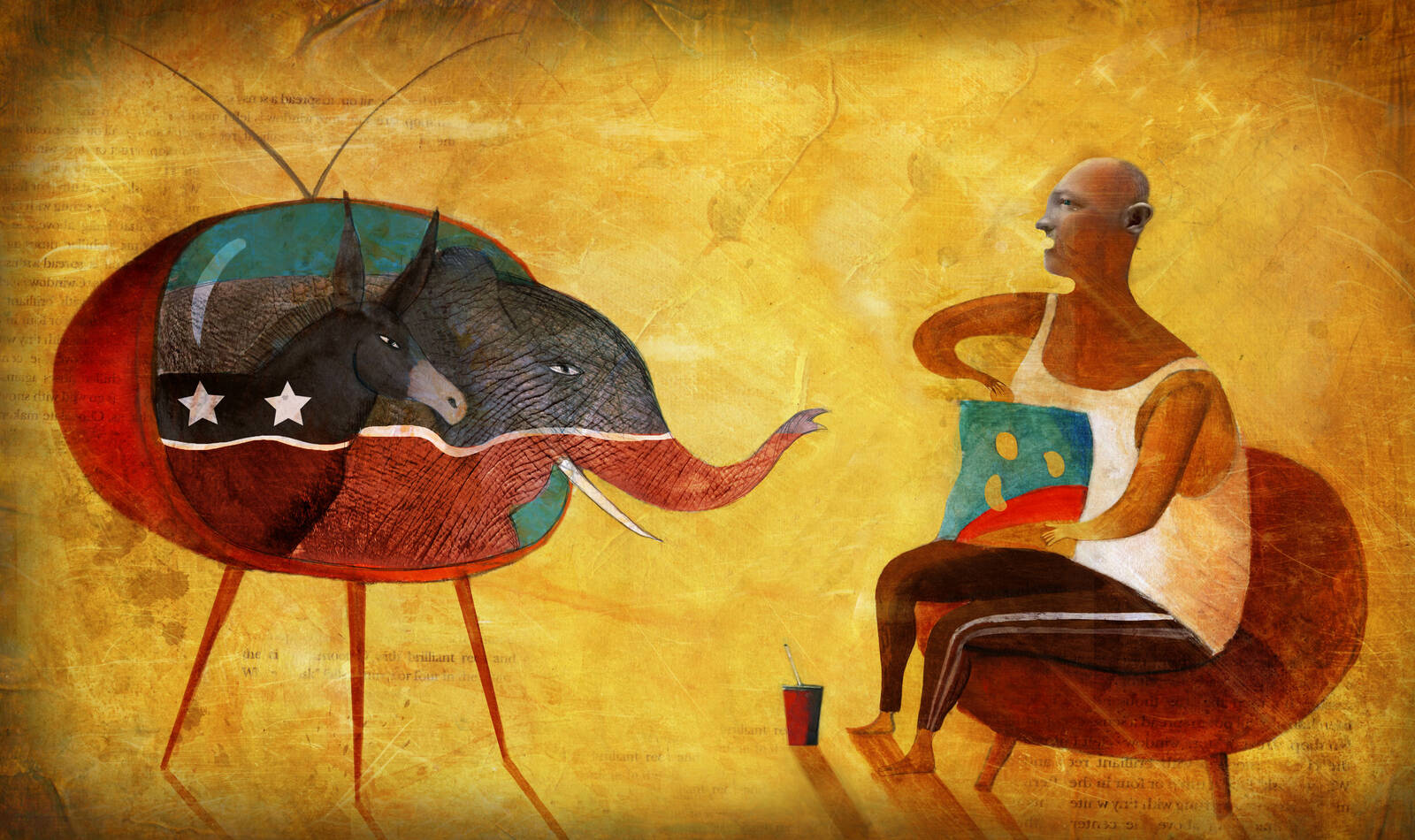Politics & Elections Jan 4, 2016
To Rally Your Base, Buy Air Time
How political advertising is a zero-sum game.

Yevgenia Nayberg
As the 2016 presidential primaries approach, voters in key states are being inundated with political ads every time they turn on the TV. But how much do these costly advertisements actually impact election results?
Decades of conventional social-science wisdom would say not much. The so-called “minimal-effects hypothesis,” formulated in the mid–20th century, asserts that political TV ads do not help get out the vote, with numerous studies showing that ads had little to no impact on aggregate voter turnout. More recent studies have cast doubts on the hypothesis. Still, “there’s no consensus,” says Jörg Spenkuch, who studies voting systems at the Kellogg School of Management.
Spenkuch found this lack of conclusive evidence troubling. “It seems implausible that political advertising only has minimal effects,” he says. “It would mean that campaigns are making billion-dollar mistakes every four years.”
“This is about getting your own supporters off the couch and to the polls.”
Spenkuch, an assistant professor of managerial economics and decision sciences, and coauthor David Toniatti of the economic consulting firm Analysis Group, used a clever quasi-experimental approach based on data from the 2004 and 2008 presidential races to answer this question. Their findings: political advertisements do not change overall voter turnout, but they do impact which candidate gets the most votes by rallying that candidate’s base.
Television and Turnout
The minimal-effects hypothesis has often resisted empirical inquiry. The researchers’ solution was to get unusual access to Nielsen’s television-audience measurement system.
“Most previous research relied on self-reported media consumption, but we are the first to have access to actual Nielsen ratings data,” Spenkuch says.
This new dataset let them focus on voters living in counties on the border of adjacent TV “media markets” set by the FCC. Campaigns make ad buys based on these media markets and often place a different number of ads in adjacent markets. This means that people in adjacent counties who happen to be in different media markets may be very similar demographically—and yet they are seeing different numbers of ads. This creates a near-perfect scenario to study the impact of advertisements on voting behavior.
When Minimal Effects Matter
This novel analysis did not instantly overturn the minimal-effects hypothesis.
“Does more political advertising increase voter turnout in general? No, it does not,” Spenkuch says. “But then we dug deeper. We obtained official voter registration lists for the lower-48 states. What the individual voter registration data lets us do is look at the composition of the electorate, not just its size.”
The researchers found that airing TV campaign ads does cause a corresponding shift in “vote shares” in favor of the candidate who airs more ads. Essentially, the candidate airing more ads gets a bigger share of the same total number of voters.
Interestingly, this does not mean that these ads are swaying independent voters one way or another. Instead, the ads serve to catalyze a candidate’s base. The researchers were able to see this by analyzing election data that categorized individual voters as Democrat, Republican, or Independent/Not Declared to see who was turning out to vote in border counties.
“When one party advertises more than the other, core supporters of that candidate are more likely to go to the polls and supporters of the opponent are less likely to vote,” Spenkuch says. “This rationalizes why campaigns advertise so much despite showing only ‘minimal’ effects on aggregate turnout.”
Playing the Odds
The findings do not suggest a simple equation for winning presidential elections with TV ad buys. “We can’t extrapolate without hesitation,” Spenkuch says, “but I think the implication is that a lot of political advertising is going to be a zero-sum game,” meaning a gain for one candidate is a loss for the other.
In cases like the counties that Spenkuch and Toniatti studied, televised attempts to sway independent voters are likely to fall on deaf ears. If a significant number of independent voters were motivated to go to the polls by TV advertising, the data would show an increase in overall turnout, not just in vote shares. But this was not the case.
“This is about getting your own supporters off the couch and to the polls, more like local ground operations,” Spenkuch says.
The precise dynamics of political advertising may differ in major media markets and in urban population centers. But Spenkuch says that his results still point a stern finger at the effects of money on the democratic process.
“It’s possible for deep-pocketed donors to influence election results simply by airing more ads,” he says. “That is presumably a huge concern for public policy.”
Indeed, the 2000 Bush presidential campaign ran twice as many ads in Florida as did the Gore campaign.
“If the difference had been narrowed to zero,” Spenkuch says, “Bush would have lost about 2% of the popular vote relative to Gore. And we’d have had a different president.”
Spenkuch, Jorg, and David Toniatti. “Political Advertising and Election Outcomes.” Working paper.



